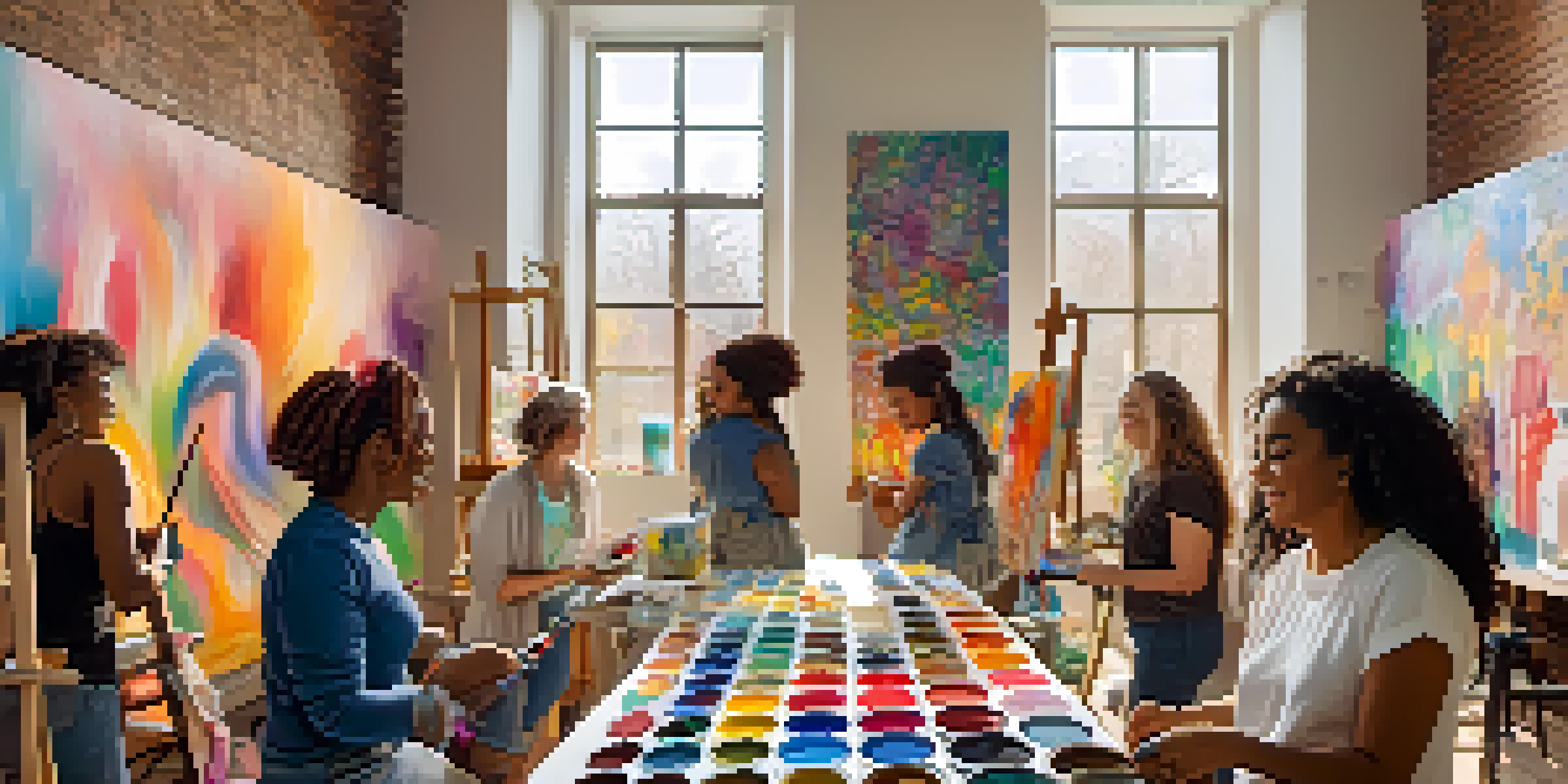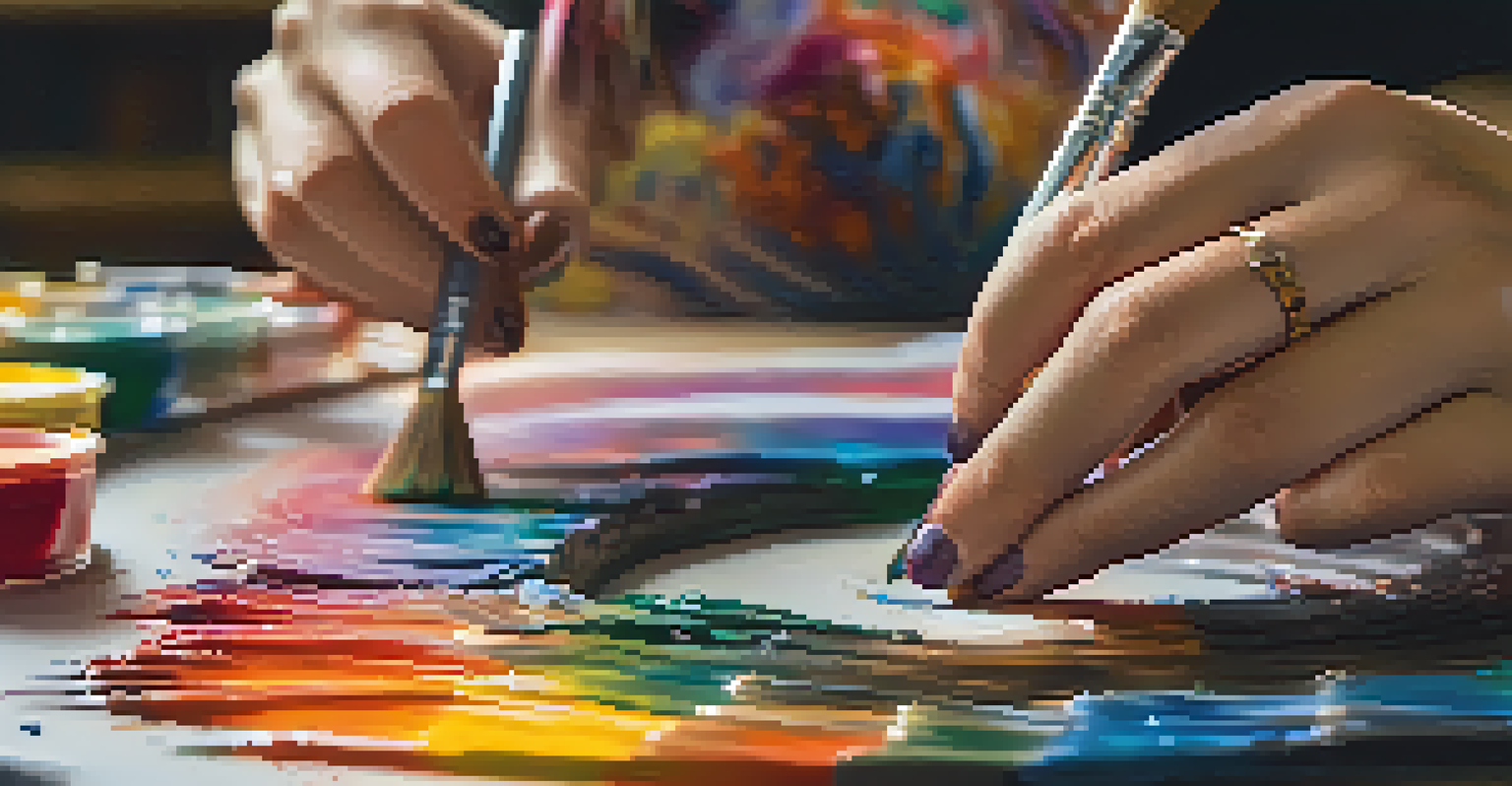Breaking Stereotypes: Women Artists Challenging Norms Today

The Evolving Landscape of Women in Art
Historically, women artists have faced significant barriers in the art world, often overshadowed by their male counterparts. However, the landscape is changing, with more women stepping into the spotlight, showcasing their talents and unique perspectives. This shift not only highlights the creativity of women but also challenges the traditional narratives that have long defined art.
Women artists are not just breaking through glass ceilings; they are shattering them.
Today, women artists are not just participating; they are leading conversations around identity, culture, and social issues. They are using their platforms to address topics that resonate with diverse audiences, creating art that speaks to the human experience. This evolution is a testament to the resilience and determination of women who refuse to be confined by stereotypes.
As we explore the contributions of women artists today, it’s essential to recognize that they are not just breaking through glass ceilings; they are shattering them. By redefining what it means to be an artist, they are inspiring future generations to express themselves authentically and fearlessly.
Challenging Artistic Norms Through Diversity
Diversity in art is not just about representation; it's about the richness that various perspectives bring to the canvas. Women artists draw from their unique backgrounds, cultures, and experiences, enriching the art world in ways that transcend traditional norms. This diversity fosters innovation, allowing new styles and techniques to flourish.

For instance, artists like Yayoi Kusama and Frida Kahlo have woven their personal narratives into their work, challenging viewers to confront societal issues. Their art not only reflects their identities but also invites audiences to engage with broader themes of mental health, feminism, and cultural heritage. This blend of personal and political is a powerful tool for change.
Women Artists Redefining Art
Women artists are breaking through barriers and reshaping artistic norms, inspiring future generations with their unique perspectives.
By embracing diversity, women artists are reshaping the very definition of what constitutes art. They are proving that creativity knows no bounds, and every story matters, making the art world a more inclusive and inspiring place.
The Role of Technology in Empowering Women Artists
In today's digital age, technology plays a pivotal role in how artists connect with audiences. Social media platforms and online galleries have become essential tools for women artists to showcase their work and engage with a global audience. This accessibility has leveled the playing field, allowing talent to shine without the constraints of traditional gatekeeping.
Art is a powerful medium for social change and collective healing.
For example, artists like Amanda Oleander use platforms like Instagram to share their art and process with followers, building a community around their work. This direct connection enables women artists to gain recognition and support, often leading to opportunities that might not have been available through conventional channels.
Moreover, technology allows for the exploration of new mediums, such as digital art and virtual reality, expanding the possibilities for creative expression. By embracing these innovations, women artists are not only enhancing their craft but also redefining how art is experienced and understood.
Highlighting the Voices of Marginalized Women Artists
While the art world has made strides, many marginalized women artists still face significant challenges. These artists often grapple with intersecting identities, which can complicate their access to resources and visibility. However, their work is vital in amplifying voices that have been historically silenced.
Initiatives like the 'Women of Color in the Arts' project aim to uplift these artists, providing support and platforms to showcase their talents. By focusing on their narratives, these initiatives challenge the dominant culture and encourage conversations around representation and equity in the art world.
Diversity Fuels Artistic Innovation
The inclusion of diverse voices in the art world enriches creativity and challenges traditional norms, leading to powerful societal conversations.
Highlighting the work of marginalized women artists not only enriches our understanding of art but also fosters empathy and connection among diverse communities. Their contributions remind us that art is a powerful medium for social change and collective healing.
Women Artists and the Intersection of Feminism
Feminism and art have long been intertwined, with women artists using their work to advocate for gender equality and social justice. Through their art, they challenge societal norms and provoke thought, encouraging viewers to question the status quo. This intersectionality is crucial in understanding the broader implications of their work.
Artists like Judy Chicago and Tracey Emin have used their platforms to address feminist themes, from the female experience to body politics. Their bold expressions invite audiences to confront uncomfortable truths, fostering dialogue around women's rights and representation. This dynamic engagement is a hallmark of feminist art.
By embracing feminism, women artists are not only reclaiming their narratives but also inspiring others to join the movement. Their courage to speak out through art reinforces the idea that creativity can be a catalyst for change, motivating others to challenge societal norms.
The Impact of Women Artists on Future Generations
The influence of women artists extends beyond their own work; it has a lasting impact on future generations. By breaking down barriers and redefining artistic norms, they are paving the way for young women to pursue careers in the arts without hesitation. This legacy of empowerment fosters a culture of creativity and self-expression.
Educational programs and mentorship initiatives aimed at young women artists are essential in nurturing talent and providing guidance. Programs that connect aspiring artists with established professionals help build confidence and skill, ensuring that the next generation is equipped to thrive in the art world.
Technology Empowers Women Artists
Digital platforms have become vital tools for women artists to showcase their work and connect with a global audience, fostering recognition and support.
As these young women step into their roles as artists, they carry forward the lessons learned from their predecessors. This cycle of empowerment creates a vibrant community where creativity flourishes, and the voices of women in art continue to resonate and inspire.
Conclusion: Celebrating the Journey of Women Artists
The journey of women artists is one of resilience, creativity, and transformation. As they challenge stereotypes and reshape the art world, they remind us of the power of expression and the importance of diverse voices. Celebrating their contributions is essential in recognizing the intricate tapestry of perspectives that enrich our cultural landscape.
By supporting women artists, we not only uplift their work but also contribute to a more inclusive and equitable art community. This celebration is not just about acknowledging their achievements but also about committing to ongoing support and recognition for their contributions.

As we look to the future, let’s continue to champion women artists and encourage the next generation to break free from stereotypes. Together, we can create a vibrant art world that reflects the diverse stories and experiences of all women.